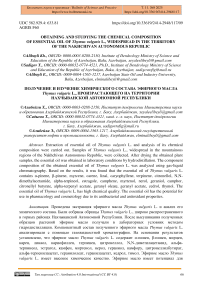Obtaining and studying the chemical composition of essential oil of Thymus vulgaris L., widespread in the territory of the Nakhchivan Autonomous Republic
Автор: Alibayli Kh., Sadigov T., Alibayli E.
Журнал: Бюллетень науки и практики @bulletennauki
Рубрика: Естественные науки
Статья в выпуске: 8 т.11, 2025 года.
Бесплатный доступ
Extraction of essential oil of Thymus vulgaris L. and analysis of its chemical composition were carried out. Samples of Thymus vulgaris L., widespread in the mountainous regions of the Nakhchivan Autonomous Republic, were collected. After drying the obtained plant samples, the essential oil was obtained in laboratory conditions by hydrodistillation. The component composition of the obtained essential oil of Thymus vulgaris L. was analyzed using gas-liquid chromatography. Based on the results, it was found that the essential oil of Thymus vulgaris L. contains α-pinene, β-pinene, myrcene, carene, linal, caryophyllene, terpinene, citronellol, N,N-dimethylacetamide, alpha-terpineol, estragole, camphene, myrtenol, nerol, geraniol, camphor, citronellyl butyrate, alpha-terpenyl acetate, geranyl oleate, geranyl acetate, cedrol, thymol. The essential oil of Thymus vulgaris L. has high chemical quality. The essential oil has the potential for use in pharmacology and cosmetology due to its antibacterial and antioxidant properties.
Thymus vulgaris l, essential oil, chromatography, antibacterial, industry, medicine, cosmetology
Короткий адрес: https://sciup.org/14133569
IDR: 14133569 | УДК: 582.929.4: | DOI: 10.33619/2414-2948/117/09
Текст научной статьи Obtaining and studying the chemical composition of essential oil of Thymus vulgaris L., widespread in the territory of the Nakhchivan Autonomous Republic
Бюллетень науки и практики / Bulletin of Science and Practice
The flora of the Nakhchivan Autonomous Republic has rich plant resources. Essential oil plants also occupy a special place in this wealth. Currently, up to 2000 essential oil plants are known to science. Essential oil is found in all organs of plants in small or large quantities. Due to the richness of its chemical composition and the prospects for use, one of the most widely used genera of the Dalamazomycete family is thyme. 7 species of the genus are distributed in the Nakhchivan Autonomous Republic. Thyme is one of the most widely used plants in the medical and food industries worldwide due to the chemical compounds it contains. The biologically active substances of this plant are concentrated in its aboveground green parts and show the highest amount in the flowering phase. The aboveground green parts of thyme species growing in Azerbaijan contain from 0.12% to 1.75% essential oil. In the dry and hot climate of the Nakhchivan Autonomous Republic, the essential oil yield of thyme species varies from 1.45% to 1.75% (1.80%). Thyme plant, which is rich in essential oil, has been studied by many Azerbaijani scientists from time to time, and its industrial importance and areas of application in medicine have been investigated [1-3, 6, 7].
The main objective of the research work is to study the chemical composition and uses of essential oil obtained from Thymus vulgaris L. species.
Materials and methods
For the implementation of the research work, samples of the Thymus vulgaris L. species, which are widespread in the mountainous areas of the Nakhchivan Autonomous Republic, were collected. The collection process was carried out in the morning hours, during the flowering stage of the plant. The collected material was dried in the shade. Essential oil was obtained from the dried Thymus vulgaris L. species in the “Industrially Important Plants” laboratory of the Institute of Dendrology by the hydrodistillation method (Ginzberg) (Figure 1).
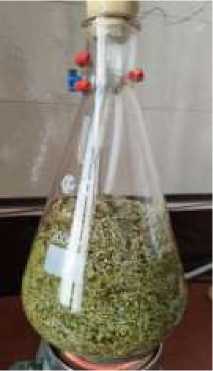
Figure 1. Extraction of essential oil from Thymus vulgaris L.
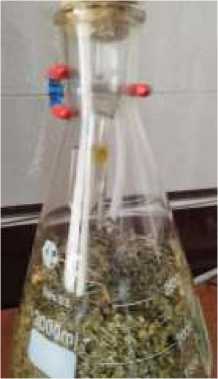
The component composition of the essential oil was analyzed using a “Kristal” 2000 M gasliquid chromatography [4, 5].
Based on the results of the analysis, Thymus vulgaris L. essential oil contains α-Pinen — 24,320%, β-Pinen — 0,097%, Myrcene — 0,081%, Carene-3 — 0,148%, Linaool — 1,979%, Cariophyllene — 6,750%, Terpinen-4-ol — 1,719%, Citronellol — 7,691%, N,N dimethyl acetamide — 0.022%, alpha-terpineol — 0.401%, Estragole — 0.398%, camphene — 0.169%, myrtenol — 0.998%, Nerol — 3.985%, geraniol0 — 487%, camphor — 1.204%, Citronelly butyrate — 30.234%, alpha-Terpenylacetate — 0.085%, Geranyl Oleate — 6.759%, Geranilacetate — 0.121%, Cedrol — 0.760%, Thymol — 0.148% were determined.
Conclusion and discussion
Common thyme ( Thymus vulgaris L.) is a perennial herbaceous plant belonging to the Lamiaceae family (Lamiaceae Lindl.). There are different opinions in the literature regarding the distribution of thyme on Earth. Some sources indicate that there are 400 species of thyme in the temperate zone of Eurasia and North America. It is reported that there are 38 species of thyme on Earth (excluding tropical countries) [9].
The homeland of thyme is considered to be the Mediterranean coast. All species of the genus Thyme are essential oil plants. The roots and leaves are usually covered with hairs that carry essential oil. Thyme, a wild semi-shrub, is collected when it is in bloom as a high-quality raw material and medicinal plant. The collected herb should be dried in a shady place or in a drying cabinet [8, 10].
During the conducted research, the hydrodistillation method was applied to obtain essential oil from Thymus vulgaris L. species collected from the mountainous areas of the Nakhchivan Autonomous Republic. During the hydrodistillation process, 200 grams of dried thyme plant were used (Figure 2).
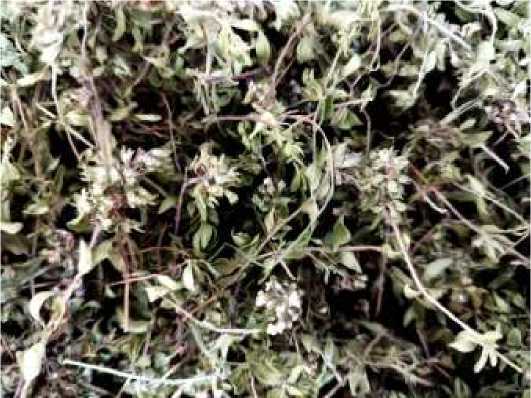
Figure 2. Thymus vulgaris L. species
During the experiment, 2.2 ml of essential oil was obtained. The yield percentage of the obtained essential oil was calculated using the following formula.
Y (%) =( — ) × 100
Essential oil yield (%) = (Amount of essential oil obtained / mass of dried plant) ×100
Yield (%) = (2.2 / 200) ×100 = 1.1%
The quality of the essential oil obtained depends on the dynamic development phase of the plant. Productivity can vary depending on the geographical region where the plant is grown, as well as climatic conditions. Thyme can be found on sandy slopes, grassy areas, and low-humidity areas [11]. The composition of the essential oil obtained from Thymus vulgaris L. was studied using a “Kristall” 2000 M gas-liquid chromatography. The results are shown in Table.
Table CHEMICAL COMPOSITION OF Thymus vulgaris L. ESSENTIAL OIL
|
земя, лн |
Компонент |
Группа Площадь |
Высота |
Площадь, концентрация /о |
Ед. концентрации |
Детектор |
|
8.464 |
alfa-pinen |
13893.082 |
2204.768 |
24.320 |
ПИД-1 |
|
|
9.011 |
161.658 |
80.259 |
0.283 |
ПИД-1 |
||
|
9.217 |
24.519 |
13.022 |
0.043 |
ПИД-1 |
||
|
9.429 |
beta-Pinen |
55.621 |
19.315 |
0.097 |
ПИД-1 |
|
|
9.593 |
Mircen |
46.007 |
20.488 |
0.081 |
ПИД-1 |
|
|
9.979 |
Carene-3 |
84.566 |
40.187 |
0.148 |
ПИД-1 |
|
|
10.098 |
40.570 |
18.711 |
0.071 |
ПИД-1 |
||
|
10.241 |
832.403 |
340.373 |
1.457 |
ПИД-1 |
||
|
10.661 |
4.904 |
3.431 |
0.009 |
ПИД-1 |
||
|
12.758 |
53.847 |
16.352 |
0.094 |
ПИД-1 |
||
|
13.243 |
14.208 |
5.458 |
0.025 |
ПИД-1 |
||
|
13.461 |
103.288 |
34.896 |
0.181 |
ПИД-1 |
||
|
13.723 |
35.036 |
11.577 |
0.061 |
ПИД-1 |
||
|
14.182 |
linaool |
1130.462 |
313.863 |
1.979 |
ПИД-1 |
|
|
14.481 |
Cariophyllene |
3855.678 |
1093.080 |
6.750 |
ПИД-1 |
|
|
14.689 |
32.838 |
10.529 |
0.057 |
ПИД-1 |
||
|
14.788 |
145.891 |
35.253 |
0.255 |
ПИД-1 |
||
|
15.125 |
Terpinen-4-ol |
982.241 |
257.985 |
1.719 |
ПИД-1 |
|
|
15.335 |
Citronellol |
4393.240 |
1196.665 |
7.691 |
ПИД-1 |
|
|
15.463 |
38.459 |
14.233 |
0.067 |
ПИД-1 |
||
|
15.665 |
N,N di methyl acetamid |
12.321 |
5.373 |
0.022 |
ПИД-1 |
|
|
15.815 |
256.463 |
52.541 |
0.449 |
ПИД-1 |
||
|
16.133 |
alfa-terpineol |
228.992 |
65.950 |
0.401 |
ПИД-1 |
|
|
16.193 |
Estragole |
227.351 |
57.462 |
0.398 |
ПИД-1 |
|
|
16.334 |
kamfen |
96.465 |
27.410 |
0.169 |
ПИД-1 |
|
|
16.445 |
mirtenol |
570.044 |
144.419 |
0.998 |
ПИД-1 |
|
|
16.625 |
Nerol |
2276.534 |
489.250 |
3.985 |
ПИД-1 |
|
|
16.755 |
geraniol |
278.393 |
62.182 |
0.487 |
ПИД-1 |
|
|
17.077 |
camphor |
687.706 |
141.219 |
1.204 |
ПИД-1 |
|
|
17.231 |
Citronelly butyrate |
17271.469 |
3700.318 |
30.234 |
ПИД-1 |
|
|
17.463 |
150.239 |
48 445 |
0.263 |
ПИД-1 |
||
|
17.598 |
alfa-Terpenilacetat |
48.772 |
18.638 |
0.085 |
ПИД-1 |
|
|
17.672 |
179.589 |
59.416 |
0.314 |
ПИД-1 |
||
|
17.725 |
271.648 |
78.166 |
0.476 |
ПИД-1 |
||
|
18.151 |
Geranyl Oleate |
3860.911 |
1024.699 |
6.759 |
ПИД-1 |
|
|
18.610 |
260.649 |
72.057 |
0.456 |
ПИД-1 |
||
|
18.872 |
16.861 |
6.637 |
0.030 |
ПИД-1 |
||
|
19.180 |
43.857 |
14.581 |
0.077 |
ПИД-1 |
||
|
19.755 |
41.942 |
13.590 |
0.073 |
ПИД-1 |
||
|
20.053 |
235.549 |
67.630 |
0.412 |
ПИД-1 |
||
|
20.193 |
geranilacetat |
69.359 |
19.976 |
0.121 |
ПИД-1 |
|
|
20.327 |
52.766 |
17.073 |
0.092 |
ПИД-1 |
||
|
20.401 |
38.697 |
11.712 |
0.068 |
ПИД-1 |
||
|
20.930 |
915.402 |
150.577 |
1.602 |
ПИД-1 |
||
|
21.101 |
81.818 |
19.748 |
0.143 |
ПИД-1 |
||
|
21.232 |
847.058 |
214.652 |
1.483 |
ПИД-1 |
||
|
21.371 |
Cedrol |
434.200 |
109.609 |
0.760 |
ПИД-1 |
|
|
22.167 |
14.045 |
5.674 |
0.025 |
ПИД-1 |
||
|
22.275 |
221.218 |
36.744 |
0.387 |
ПИД-1 |
||
|
22.551 |
384.939 |
76.115 |
0.674 |
ПИД-1 |
||
|
22.658 |
618.924 |
126.144 |
1.083 |
ПИД-1 |
||
|
23 123 |
417.734 |
95.981 |
0.731 |
ПИД-1 |
||
|
24.133 |
Thymol |
84.793 |
18.952 |
0.148 |
ПИД-1 |
The quality of essential oil extracted from plants depends on the dynamic phase of development. Yields can vary depending on the geographical region and climatic conditions where the plant is grown.
Thymus L. — thyme plant is rich in essential oil, so it is widely used in folk medicine, medicine, pharmacology, cosmetics, perfumery industry, and household as a spice. Essential oils obtained from all species of the genus Thymus ( Thymus L) have antiviral and antibacterial effects. Thymus plant is also rich in vitamins A and C, calcium, sodium and potassium. Tea made from thyme is also widely used in folk medicine. Thymus vulgaris L., which belongs to the genus Thymus ( Thymus L.), was used in the research work.
Studies have shown that thyme essential oil is rich in naturally occurring bioactive substances and has wide application potential in medicine, pharmacy, and cosmetology. To obtain high-quality essential oil, it is important to apply proper distillation methods and take into account the growing conditions of the plant.
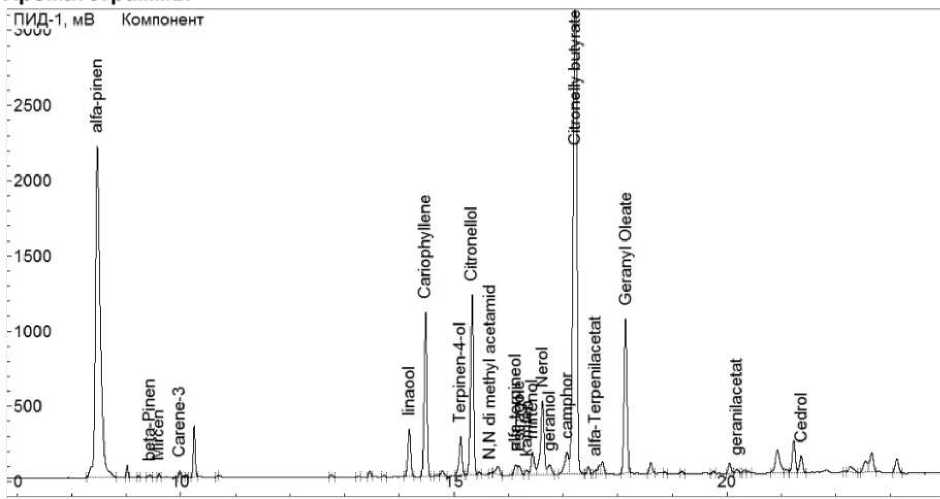
Figure 3. Chromatography of the chemical composition of Thymus vulgaris L essential oil
Conclusion
As a result of the conducted scientific research, high-quality essential oil was obtained from the Thymus vulgaris L. plant and its component composition was studied using a "Kristal" 2000 M gas-liquid chromatography. Based on the results of the analysis, Thymus vulgaris L. essential oil contains: α-Pinen — 24,320%, β-Pinen — 0,097%, Myrcene — 0,081%, Carene-3 — 0,148%, Linaool-1,979%, Cariophyllene- 6,750%, Terpinen-4-ol-1,719%, Citronellol-7,691%, N,N dimethyl acetamide — 0.022%, alpha-terpineol — 0.401%, Estragole — 0.398%, camphene — 0.169%, myrtenol — 0.998%, Nerol — 3.985%, geraniol — 0.487%, camphor — 1.204%, Citronelly butyrate — 30.234%, alpha-Terpenylacetate — 0.085%, Geranyl Oleate — 6.759%, geranilacetate — 0.121%, Cedrol — 0.760%, Thymol — 0.148% were determined. These components indicate that the essential oil has high biological activity. Thymus vulgaris L. essential oil can be considered promising for pharmacology and cosmetology due to its antibacterial and antioxidant properties. Also, its use in perfumery and cooking is undeniable due to its beautiful aroma. Thymus vulgaris L. essential oil, which has a multifaceted importance, is suitable for widespread use in various fields of industry.
Бюллетень науки и практики / Bulletin of Science and Practice Т. 11. №8 2025

